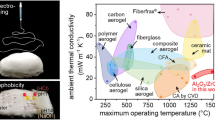Abstract
Open-cell ceramic foams are new class of materials with wide range of engineering applications due to their unique combination of thermal, structural and mechanical properties. These materials have not been well explored in the field of energy absorption applications due to their inherent brittleness in nature. In the present investigation, the alumina (Al2O3)-based ceramic foams with different pore sizes such as 10 PPI, 20 PPI, 30 PPI (pores per inch) were fabricated by the polymer sponge replication process. Attempt was made to modify the brittle nature of ceramic foams with energy absorption property by aluminium molten metal infiltration. All the fabricated samples were tested under quasistatic compression test. This study revealed that 30 PPI foam had high energy absorption property compared to all other foams, and also this energy absorption properties had been significantly enhanced through infiltration due to composite effect.




Similar content being viewed by others
References
Biswas P, Ramavath P, Nair C M, Suresh M B, Ravi N, and Johnson R, Ceram Int 42 (2016) 10572.
Schwartzwalder K, and Somers A V, Method of Making Porous Ceramic Articles, US Patent No. 3090094, May 21, 1963.
Studart A R, Gonzenbach U T, Tervoort E, and Gauckler L J, J Am Ceram Soc 89 (2006) 1771.
Maiti S K, Gibson L J, and Ashby M F, Acta Metall 32 (1984) 1963.
Mahajan Y R, and Johnson R, in Materials Research: Current Scenario and Future Projections, (ed) Chidambaram R, Materials Research Society of India, 2002 (in press).
Lefebvre L-P, Banhart J, and Dunand D C, Porous Metals and Metallic Foams: Current Status and Recent Developments.
Then P M, and Day J P, Interceram 49 (2000) 20.
Yukihiro Y, Japan Patent No. JP11264-682A2, 28 September, 1999.
Alvin M A, Lippert T E, and Lane J E, Am Ceram Soc Bull 70 (1991) 1491.
Degischer H P, and Kriszt B, Handbook of Cellular Metals: Production, Processing, Applications, Wiley-VCH Verlag GmbH, Weinheim (2002).
Mahajan Y R, Johnson R, Saha B P, Bhattacharjee S, and Rao V V S, Indian Patent Application No. 30/MAS/99, 7 January, 1999.
Raju V, Johnson R, and Khanra A K, J Alloys Compd 750 (2018) 71.
Author information
Authors and Affiliations
Corresponding author
Rights and permissions
About this article
Cite this article
Vemoori, R., Gurram, U. & Khanra, A.K. Fabrication and Properties Evaluation of Alumina-Based Open-Cell Foams. Trans Indian Inst Met 72, 1679–1682 (2019). https://doi.org/10.1007/s12666-019-01578-3
Received:
Accepted:
Published:
Issue Date:
DOI: https://doi.org/10.1007/s12666-019-01578-3




